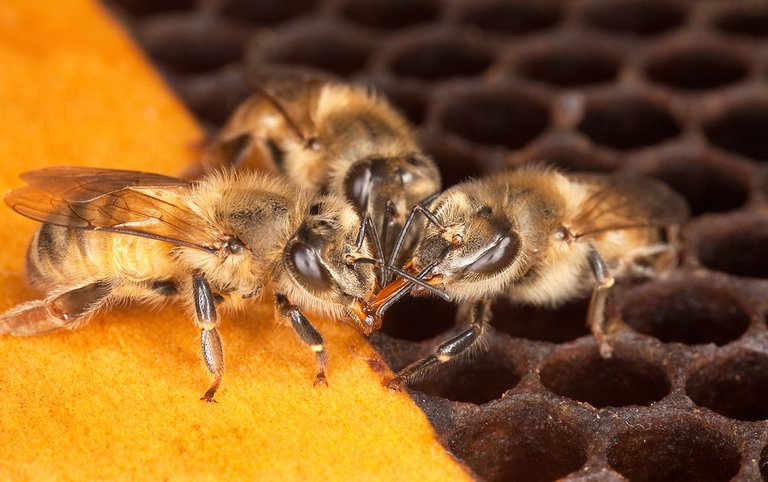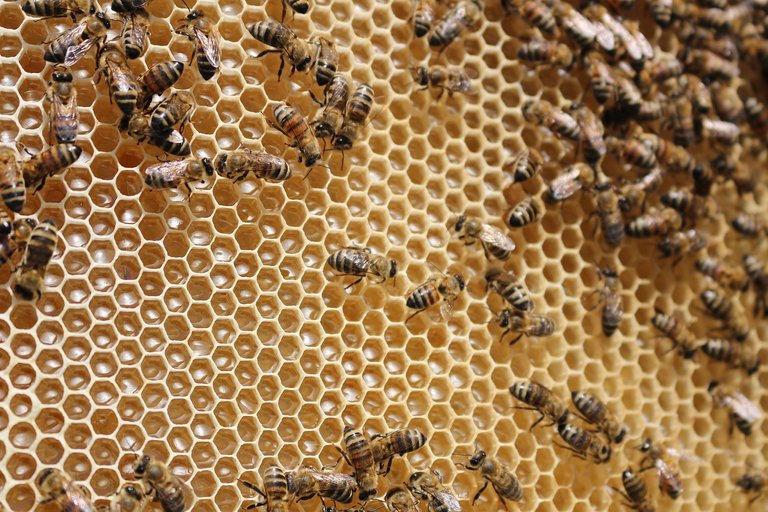Colony Collapse Disorder in Bees.
I decided to digress a little bit and move from talking about just household pets into considering other animals that are not household pets, in my last post I wrote about sea stars and I hope you found it educating, today, I will be writing about a condition that affects Honey bees, it is a huge diversification from what I am used to writing, and I was so eager to learn about it. Today, I will be touching on the topic "Colony collapse disorder".

flickr.com
Colony collapse disorder is what happens when the majority of bee workers in a colony disappear, and leave the queen behind, they do this putting into consideration the needs of the queen and the immature bees, so they leave behind lots of food and a few nurse bees who would care for the queen as well as the immature bees.
Around 2005, it was reported that honey bookkeepers in the USA started to suffer a significant loss of bees, and colony loss continuously recurred on a yearly basis, after this observation, another bookkeeper described the situation as ''The law of thirds; which means one-third were found dead, one-third were found weak and the other one-third were fine, after careful observation, the high mortality was then linked to the occurrence of a new disease, which is not necessarily an infectious one, with the name Colony Collapse Disorder(CCD). The disease has these symptoms;
A rapidly dying colony, but there are only a few or no dead bees around the hive.
A great loss of adult worker bees, within a few weeks, the decline rate of the adult working bees continue to significantly decline.
There is a little cluster of adult bees, with the presence of an egg-laying queen and brood.
A dead colony, but there is a presence of honey and pollen stores that are intact, and there is no invasion of hive pests like wax moths.

needpix.com
Researchers took a metagenomic survey of bees from different states in the USA, they had the aim to figure out if the presence of parasites or any pathogen could be correlated with the prevalence of CCD, this happened in the year 2006, but after careful observation, the only pathogen that was found in all the CCD samples and none of the non-CCD samples was a virus that was only being described in Israel, it is the Israeli acute paralysis virus (IAPV), the mysterious thing is that, at the time of the survey, IAPV was not known to be present in the USA, but it has been existing in Israel since 2002. However, that was not enough reason to confirm that IAPV is responsible for the occurrence of Colony collapse disorder(CCD)
Another article has described large-scale losses as not being new to the bookkeeping industry, since 1869, there have been at least 18 episodes of unusually high colony mortality that were documented internationally, before now in 1891 and 1896, there was a condition named May disease which happened in Colorado, in this case, large clusters of bees would completely disappear or significantly decline over a short period. There have been several proposed causes of CCD, with no tangible data to support it.
Just in case you are wondering why we need honey bees, I will like to inform you that, honey bee pollination is the reason why we have about $15 billion worth of crops in the United States every year, and about one-third of the diet comes either directly or indirectly from the crops that are pollinated by honey bees. Examples of crops that depend exclusively on honey bees for pollination are; cherries, berries, and almonds. In February 2007, some states also reported that they had lost over 50% of their colonies, but the absence of dead bees in the affected region made the investigation even more complex and inconclusive. In the same year, Canada, Portugal, Greece, Germany, France, Poland, and Switzerland also reported a great loss of honeybees.
Different studies have suggested that CDC may be a result of exposure to a combination of two or more stressors or pathogens, in addition to the combination of stressors, comes a synergistic effect. Bee colonies are found to commonly be infested with parasites and pathogens, but the investigation of the interactions of all the possible causative agents has remained a serious challenge for bee researchers.
In order not to leave us completely clueless about the reason behind the disease, some scientists have certain suspicions, they suspect it could be caused by the chemical contamination of the colony food supply, poisoning from pesticides like nenicotinoids, possibly the absence of genetic diversity in colonies and then the infection of colonies by a pathogen or parasites by a disease-causing agent like virus or bacteria. But, there is no still no definite cause to describe the cause of the disease, but some other researchers believe that it could come from a combination of causes.
In Conclusion.
Colony collapse disorder is a disease, which is not necessarily an infectious one, it makes the bee worker leave their colony and leave behind the queen alongside the immature bees, and some queen nurses to help take care of them, the main reason behind this disease is unknown, there have been several theories to explain this happening, but there has been no cogent scientific theory to back up this unusual occurrence. This disease is different from other bee diseases because the queen's mother is left behind with other immature bees and there is no dead bee found around.
References.
https://www.sciencedirect.com/topics/agricultural-and-biological-sciences/colony-collapse-disorder
https://www.ncbi.nlm.nih.gov/pmc/articles/PMC2715894/
https://www.ncbi.nlm.nih.gov/pmc/articles/PMC3034041/
https://www.britannica.com/science/colony-collapse-disorder/Impacts-on-honeybee-health
https://www.epa.gov/pollinator-protection/colony-collapse-disorder
https://kids.britannica.com/students/article/colony-collapse-disorder-CCD/625555
Here is your Proof of Brian. I think you meant #ProofOfBrain

Source
Thanks for your contribution to the STEMsocial community. Feel free to join us on discord to get to know the rest of us!
Please consider delegating to the @stemsocial account (85% of the curation rewards are returned).
Thanks for including @stemsocial as a beneficiary, which gives you stronger support.
Sounds like the worker bees are overworked.
LOL!! Who knows, they could be. Appreciate your time and comment.